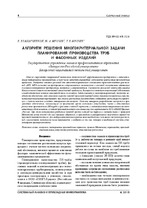| dc.contributor.author | Захарченков, К. В. | |
| dc.contributor.author | Мрочек, Ж. А. | |
| dc.contributor.author | Мрочек, Т. В. | |
| dc.coverage.spatial | Минск | ru |
| dc.date.accessioned | 2019-02-05T06:35:43Z | |
| dc.date.available | 2019-02-05T06:35:43Z | |
| dc.date.issued | 2018 | |
| dc.identifier.citation | Захарченков, К. В. Алгоритм решения многокритериальной задачи планирования производства труб и фасонных изделий = Algorithm for solution of multicriterion problem of production planning of pipes and shaped products / К. В. Захарченков, Ж. А. Мрочек, Т. В. Мрочек // Системный анализ и прикладная информатика. – 2018. – №4. – С. 4-10. | ru |
| dc.identifier.uri | https://rep.bntu.by/handle/data/49442 | |
| dc.description.abstract | Одно из современных направлений повышения экономической эффективности предприятия – автоматизация планирования производства, в том числе автоматизированное составление расписания производства
продукции. Внедрение готовых решений для автоматизированного составления производственных расписаний (APS, MES-системы) на предприятиях сдерживается сложностью и высокой стоимостью адаптации к условиям конкретного предприятия, внедрения и сопровождения. Сложность решаемой задачи обусловлена большим количеством наименований выпускаемой продукции, быстрым изменением оперативной обстановки и необходимостью четкого взаимодействия со складом. Задача является многокритериальной, поскольку необходимо обеспечить максимальную загрузку каждой производственной линии для выпуска продукции при минимальном количестве переналадок, при этом в расписании должны быть соблюдены сроки отгрузки продукции с учетом наличия исходных материалов для выпуска. Поэтому авторами разработаны алгоритм и программное обеспечение, позволяющие за приемлемое время составить допустимое, часто и оптимальное расписание производства ПИ-трубы и фасонных изделий партиями, с индивидуальным завершением последовательного обслуживания, с учетом производственных и технологических ограничений в ООО «СМИТ-Ярцево» (Россия). При этом выполняется разбиение каждой группы изделий на партии в соответствии с правилом Макнотона (wrap around rule или «правило обертки»), и производится распределение полученных партий по производственным линиям. Для выбора оптимального расписания необходимо составить несколько расписаний с различными значениями числа переналадок, и выбрать из них то, которое в наибольшей степени удовлетворяет критериям задачи. | ru |
| dc.language.iso | ru | ru |
| dc.publisher | БНТУ | ru |
| dc.title | Алгоритм решения многокритериальной задачи планирования производства труб и фасонных изделий | ru |
| dc.title.alternative | Algorithm for solution of multicriterion problem of production planning of pipes and shaped products | ru |
| dc.type | Article | ru |
| local.description.annotation | One of the modern directions of increase in economic efficiency of the enterprise is a production planning automation, including the automated scheduling of production. Introduction of ready program solutions for automated preparation of production schedules (APS, MES-systems) at enterprises is constrained by the complexity and high cost of adapting to the specific
conditions of the enterprise, implementation and maintenance. The complexity of the problem is determined by a large number of product names, rapid changes in the operational environment and the need for clear interaction with the warehouse. The task is multicriterion as it is necessary to provide the maximum loading of each production line with a minimum of readjustments, and at the same time the schedule must comply with the terms of shipment of products, taking into account the availability of raw materials for production. Therefore, the authors have developed an algorithm and software that allow for an acceptable time to make an admissible, often optimal schedule for the production of preinsulated pipes and shaped products in
batches with the individual completion of consistent service, taking into account production and technological limitations in SMITH-Yartsevo, Ltd (Russia). In this case, each group of products is divided into batches in accordance with the McNaughton rule (wrap around rule), and the resulting batches are distributed along the production lines. For the choice of the optimal schedule it is necessary to make several schedules with different values of the number of readjustments and select the one that best meets the criteria of the task. | |

